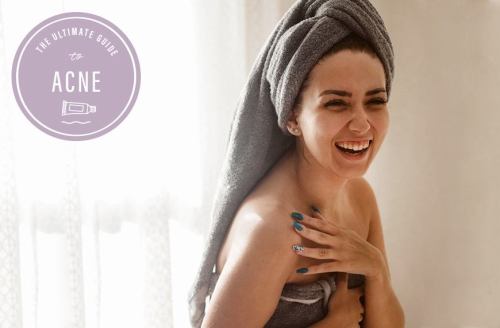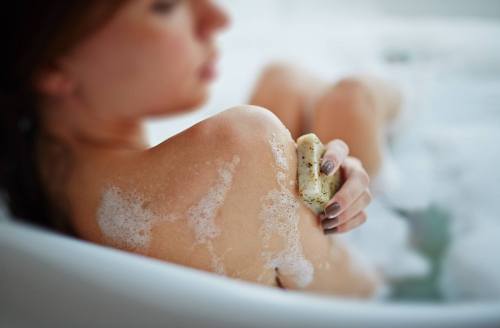Our editors independently select these products. Making a purchase through our links may earn Well+Good a commission
Boob zits happen—one derm finally clued me in as to why
Boob zits... wtf? Experts explain what causes them and how you should—and should not—try to treat them.

Boob zits… WTF.
This is how I feel every time I get into the shower, start to soap up, and spot these little pimples populating what should be a sexy spot. Then, I spend approximately five minutes wasting water while I excavate (read: pop) them, which feels like a game of whack-a-mole because my chest acne (let’s refer to it as “chestne” from here on out) breakouts are frustratingly resistant to eradication.
It’s not like I want my skin to be perfect, but I could do without these obnoxious little bubbles. After all, my boobs have enough to deal with—gravity, the after-effects of all the years I forgot to put sunscreen on the area, the male gaze, etc. Despite solidly using toners and wipes galore, I have failed to banish them forever. So, I asked the pros what the deal is—why am I prone to boob breakouts, and what can I do about it?

Keep reading to reap the benefits of my newfound boob zit knowledge.

What causes boob acne?
“When dermatologists see breakouts in a specific area—besides the typical T-zone—we call it an ‘outside job’ and look for the culprit,” says Loretta Ciraldo, MD FAAD, a Miami-based board certified dermatologist and founder of Dr. Loretta skin care. “There often, but not always, is one.” In other words, chestne is somewhat less likely to be caused by what’s going on inside the body than it is to be caused by things which come in contact with the skin. For example…
Long hair
One such offender is your hair—specifically, the pimple-producing products it can spread if it’s long enough to reach your chest. “Look for the distribution of the breakout—if it corresponds to your long hair and stops at about the length of your hair, you may be suffering from what I call an acne-formed reaction to ingredients in hair products,” says Dr. Ciraldo.
If you notice this pattern to your chestne breakouts, Dr. Ciraldo suggests paying strict attention to the ingredients in your haircare products, and the number one culprit in your formulas. “At least once a week I see a reaction to argan oil in hair products,” she says. For this reason, she suggests avoiding this ingredient as well as shea butter if you’re prone to acne around your chest, neck, or boobs. You may also want to quit your hairspray habit, because the alcohol and lacquers can provoke breakouts.
As for which products you should reach for instead? Dr. Ciraldo offers some wash-specific advice. “Switch to clear, see-through shampoo,” she says. That’s because the formulas are devoid of emollients that can clog pores when washed down the body. “Then, mix your conditioner half-and-half with Infusium 23 leave-in treatment ($13) to dilute the creamy nature of conditioner which can sometime cause acne in warmer months or if you are sweating a lot from workouts.”
The sun
Athena Ellen, a San Francisco-based holistic esthetician and founder of Monastery, explains why the sun may be behind your below-the-neck breakouts. “The sun dries the water out of your skin, dehydrating it, which makes your oil glands overgrow and overproduce in the summer,” she says. Luckily (?!?), for many of you this factor may cease to be an issue soon. (RIP summer.)
Sweat
Though sweat won’t clog your pores, Ellen says it can change the pH of your skin, making your skin more susceptible to bacteria, which can provoke breakouts. So, if you’re sweltering in the summer heat, share my addiction to Y7 (#hotyogaforlife), or are just getting your workout on regularly, you may want to consider sweat as the prime suspect in the case of your mysterious chest-specific breakouts.
This Parisian Skincare Brand Is Launching in the United States for the First Time—Here’s What a Derm Wants You to Know

We’re Calling It: Cleansing Balms Are the Face Wash of the Future—Here Are 3 to Add to Your Cart

This Is the One Product That Scarlett Johansson Always Keeps in Her Purse and on Her Bedside Table

Yeast
According to Dr. Ciraldo, your acne might not be acne at all. Instead, it might be folliculitis (the inflammation of a hair follicle) which has been perturbed by yeast on the skin. So, if you notice that you have a breakout, but it won’t go away through tried-and-true acne-busting methods, it could actually be a yeast-derived form of folliculitis and you might need to follow a different protocol.

What definitely won’t help the situation
Do as I say, not as I do (read: don’t pop!)
First and foremost, you should never pop a zit, says Dr. Ciraldo. “When you get the urge, just tell yourself your choices are to leave it and it should be gone in a few days or a week, or to pop and risk creating scar tissue that can last a lifetime,” she says. “Chests are especially prone to scars and keloids so popping is a no-no on your chest.” Instead, she advises applying a warm compress to the worst area only, which will help it come to head and resolve the issue more quickly without any risk of scarring. “If a particular lesion is very big and tender, go to the doctor and get a dilute cortisone injection, which can be put right into the lesion,” she says.
Stay away from certain soaps
As you may know, synthetic fragrance can cause a variety of skin reactions. So, it should come as no surprise that these artificial scents can also exacerbate blemishes. “Don’t use any wash with artificial color or fragrance since the inflamed skin of acne can get more red and irritated with these ingredients,” Dr. Ciraldo says.
Watch out for wipes
You may, like me, find it soothing to “clean” the skin with various wipes, but Ellen advises against it. “I would avoid all wipes as these are packed with preservatives, salts, and alcohols,” she says. “Drying out the skin is not the answer.”

How to actually eliminate these invaders
Wash after your workout
Don’t let the sweat sit, says Ellen, who advises washing directly after a workout using a gentle, fragrance-free cleanser. Most acne is due to the acid mantle of the skin being off its pH balance, which generally occurs after cleansing. “When the acid mantle is unbalanced, the brain will up its production of sebum so it can rebalance the acid mantle to its happy pH level,” she says. “When the oil arrives to the surface of the skin if the surface is too acidic, it might not be able to get out and this is when you can get congestion or acne.” Oil cleansers solve for this problem as they don’t upset the acid mantle at all. “Most people use cleansing oils on their face, but there is no reason that you can’t use them on your skin,” she says.
Salicylic acid wash
If it’s too late, and you’ve already broken out, you may want to reach for a different kind of cleanser, however. “Using a salicylic acid wash is terrific for acne, so keep one in the shower and wash with it. Our Dr. Loretta Micro Exfoliating Cleanser ($35) combines two percent salicylic and a low pH with one percent virgin cold-pressed coconut oil for its anti-acne and hydrating benefits. You can use this product like a mask, leaving it on chest for three minutes and then washing off with lukewarm water,” Dr. Ciraldo says.
Glycolic acid peels or gels
You may also want to try glycolic acid peels on the area, says Dr. Ciraldo. “I practice in Miami where there is a lot of [chest acne] all year long,” she says. To deal, she recommends pad soaked in a 10 percent glycolic acid solution, “which unglues dead cells from each other to unclog pores and resolve acne.”
Toners
Specific toners can work to help you ditch acne without drying out and/or further irritating the area—try one of these nine game-changing options, many of which are spiked with AHAs and BHAs.
Spot treatments
If you, like me, obsess over every individual zit, it might be wise to invest in a spot treatment so you can give each one individual treatment which does not involve pinching it ’til it pops. Reach for one of these seven dermatologist-recommended products to banish your blemishes.
With that, ahem, cleared up, let’s see if we can do the same for the flip side—here’s what’s causing your bacne breakouts. Plus, help us help you—take this survey for customized acne content.
Sign Up for Our Daily Newsletter
Get all the latest in wellness, trends, food, fitness, beauty, and more delivered right to your inbox.
Got it, you've been added to our email list.







